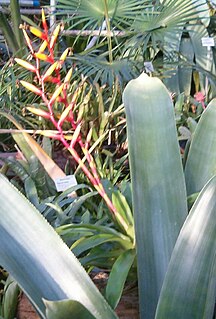
Hevea is a genus of flowering plants in the spurge family, Euphorbiaceae, with about ten members. It is also one of many names used commercially for the wood of the most economically important rubber tree, H. brasiliensis. The genus is native to tropical South America but is widely cultivated in other tropical countries and naturalized in several of them. It was first described in 1775.
Conceveiba is a plant genus of the family Euphorbiaceae, first described as a genus in 1775. It is native to South America and Central America.
- Conceveiba guianensisAubl. - Brazil, Peru, Bolivia, Ecuador, Colombia, Venezuela, 3 Guianas
- Conceveiba hostmaniiBenth. - Guyana, Suriname, Amazonas State in Brazil
- Conceveiba krukoffiiSteyerm. - Venezuela, French Guiana, NW Brazil
- Conceveiba latifoliaBenth. - Colombia, Venezuela, Peru, Amazonas State in Brazil
- Conceveiba martianaBaill. - Venezuela, French Guiana, NW Brazil, Colombia, Ecuador, Peru, Bolivia
- Conceveiba maynasensisSecco - Loreto in Peru
- Conceveiba parvifoliaMcPherson - Panama, NW Colombia
- Conceveiba pleiostemonaDonn.Sm. - Costa Rica, Nicaragua, Colombia, Venezuela
- Conceveiba praealta(Croizat) Punt ex J.Murillo - NW Brazil
- Conceveiba ptariana(Steyerm.) Jabl. - S Venezuela
- Conceveiba rhytidocarpaMüll.Arg. - Colombia, Ecuador, Peru
- Conceveiba santanderensisJ.Murillo - NW Colombia
- Conceveiba terminalis(Baill.) Müll.Arg. - Venezuela, Guyana, Suriname, NW Brazil, Colombia, Peru
- Conceveiba tristigmataJ.Murillo - Colombia, Venezuela, NW Brazil
Haematostemon is a genus of plant of the family Euphorbiaceae first described as a genus in 1919. It is native to northeastern South America.
- Haematostemon coriaceus(Baill.) Pax & K.Hoffm. - Amazonas State in S Venezuela
- Haematostemon guianensisSandwith - Potaro-Siparuni region of Guyana

Bromelia is the type genus of the plant family Bromeliaceae, subfamily Bromelioideae. Bromelia species are widespread across much of Latin America and the West Indies, and are characterized by flowers with a deeply cleft calyx. The genus is named after the Swedish medical doctor and botanist Olof Bromelius (1639-1705).
Brewcaria is a genus of plants in the family Bromeliaceae. The genus is named for Charles Brewer-Carías, Venezuelan explorer and naturalist. It contains 6 known species, all native to Colombia and Venezuela.

Aechmea nudicaulis is a bromeliad species in the genus Aechmea, which is often used as an ornamental plant. This species is native to Central America, the West Indies, central and southern Mexico, and northern and central South America.

Lindmania is a genus of plants in the family Bromeliaceae. It is one of two genera in the subfamily Lindmanioideae, and contains 39 species. All but one of the known species are native to Venezuela, a few occurring in neighboring Guyana and northern Brazil).

Guzmania lingulata, the droophead tufted airplant or scarlet star, is a species of flowering plant in the family Bromeliaceae, subfamily Tillandsioideae, native to rainforest habitats in Central America, northern and central South America and southern Mexico. It is an evergreen epiphytic perennial. The Latin word lingulata means "tongue-shaped". Foliage grows in a star-shaped basal rosette which culminates in an orange and red bracted inflorescence. It is among the most commonly cultivated bromeliad types, with cultivars producing flowers in shades of maroon, red, orange, yellow or pink.

Tillandsia stricta is a species in the genus Tillandsia. This species is native to South America and Trinidad.

Tillandsia tenuifolia, the narrowleaf airplant, is a species in the genus Tillandsia. This species is widespread across much of South America and the Caribbean islands.

Vriesea platynema is a plant species in the genus Vriesea. This species is native to the West Indies and South America.

Vriesea procera is a plant species in the genus Vriesea. This species is an epiphyte native to Trinidad and South America.
Greigia columbiana is a plant species in the genus Greigia. This species is native to Costa Rica, Panama, Colombia, Ecuador, and Venezuela.

Aechmea dichlamydea is a species of bromeliad in the genus Aechmea. This species is native to Venezuela and to Trinidad and Tobago.
Tillandsia confinis is a species in the genus Tillandsia. This species is native to Venezuela, Bolivia Colombia, Peru, northern Brazil, and Ecuador.

Tillandsia fendleri is a species in the genus Tillandsia. This species is native to the West Indies and South America.
Tillandsia turneri is a species of flowering plant in the Bromeliaceae family. This species is native to Venezuela, Colombia, Guyana, and northern Brazil.
Aratitiyopea is a monotypic genus of flowering plants, in the family Xyridaceae containing the single species Aratitiyopea lopezii. The genus was erected and described in 1984. This species is native to northern South America.

Couma is a genus of flowering plants in the family Apocynaceae first described as a genus in 1775. It is native to South America and Central America.

Stegolepis is a group of plants in the family Rapateaceae described as a genus in 1872.












